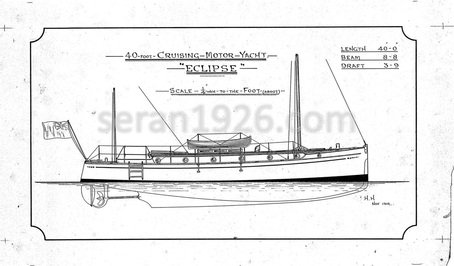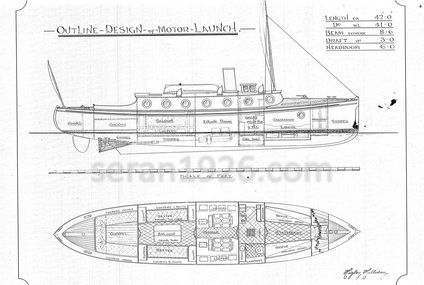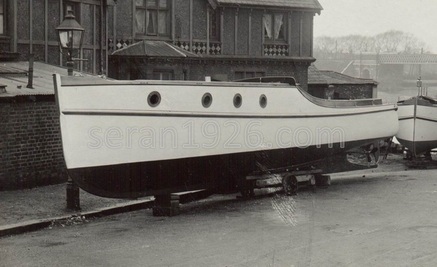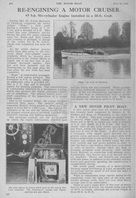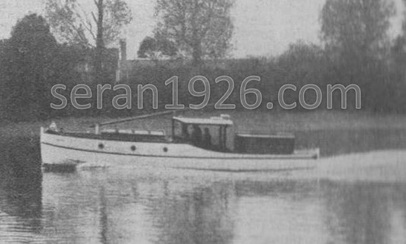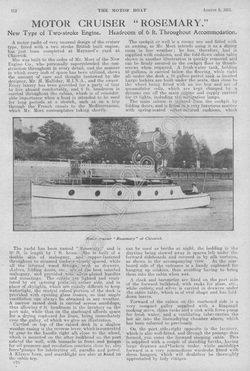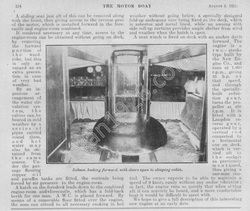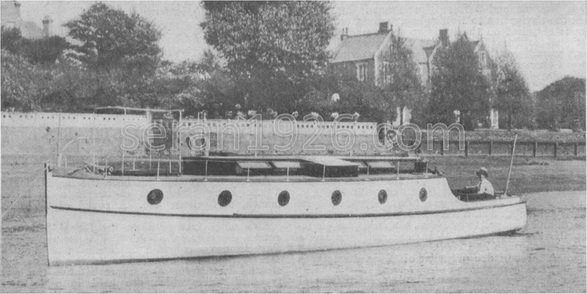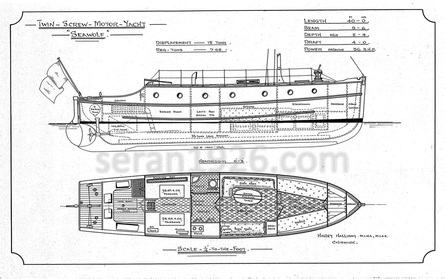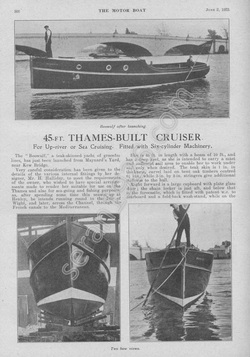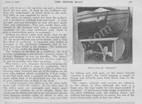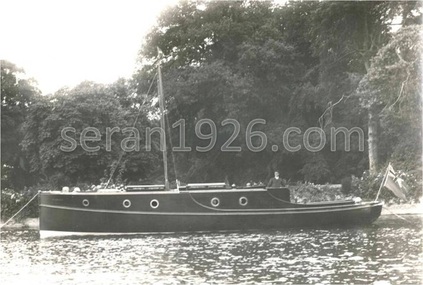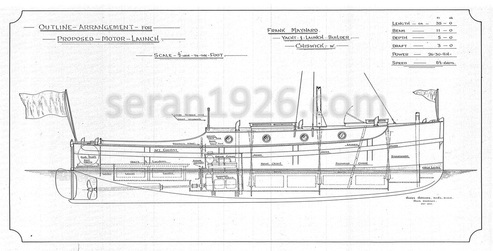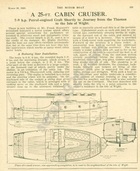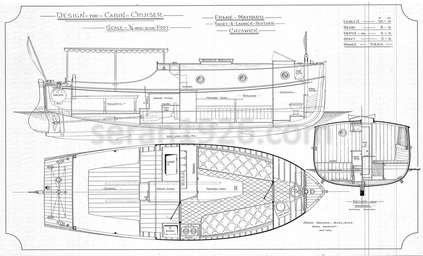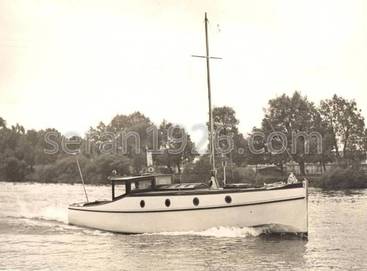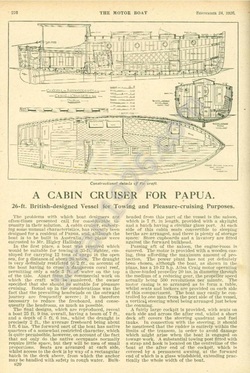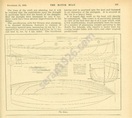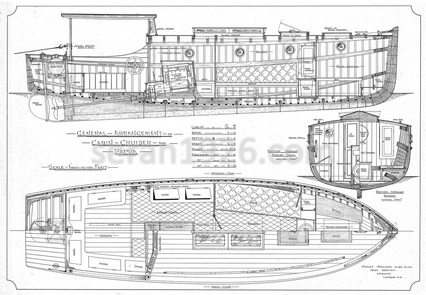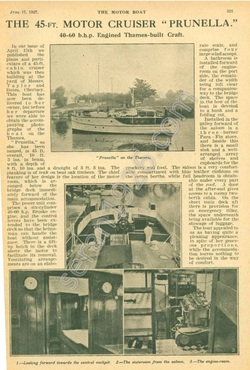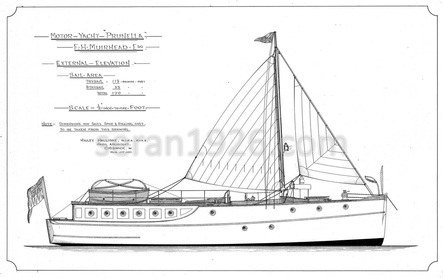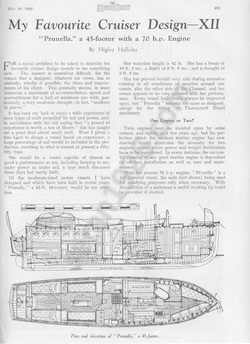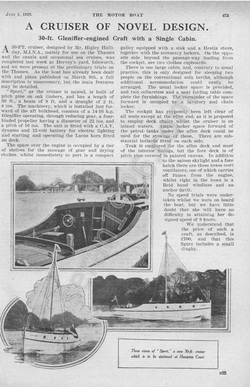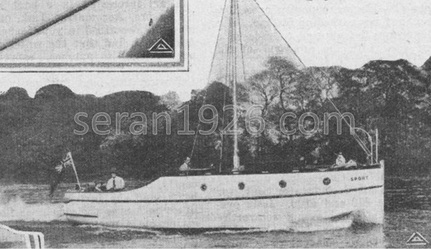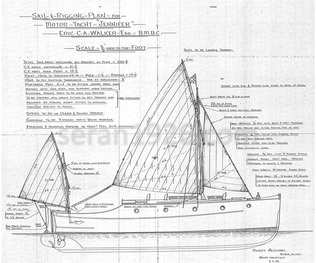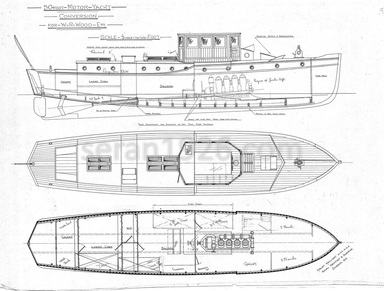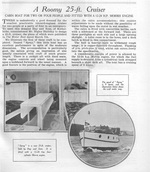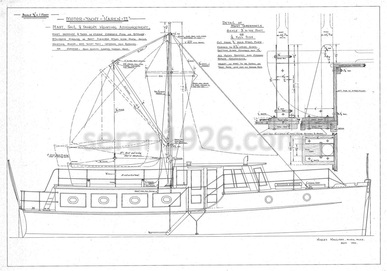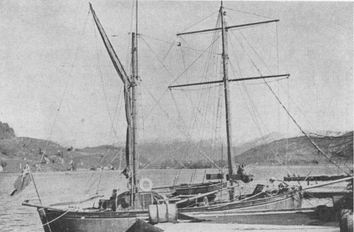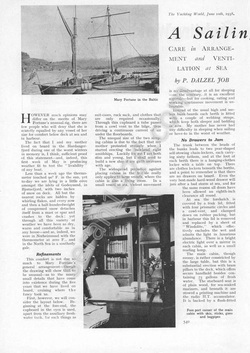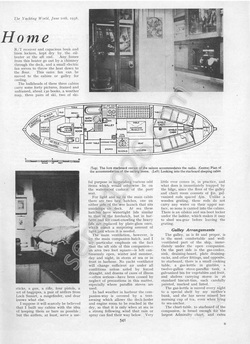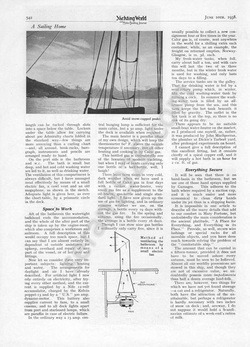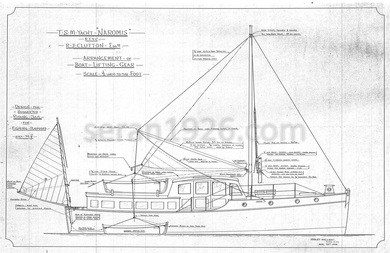IV. Halliday's Motor Yachts
"A designer, whatever his views, has to embody, wholly if possible, the ideas and requirements of his client. This generally means, in most instances...multum in parvo."
Higley Halliday, The Motor Boat, 1935
Higley Halliday, The Motor Boat, 1935
Halliday produced his earliest designs for motor yachts in
the years preceding the First World War. The earliest surviving example is his
design for the 40 ft. cruising motor yacht ‘Eclipse’ (1910), which was followed
by ‘Amice’ (1912), a 36 ft. motor yacht designed for L. M. Waterhouse, a member
of the British Motor Boat Club. Halliday found his membership of, and close
association with, the club provided a rich source of work particularly in the
post war years, completing numerous motor yacht designs for club members
including ‘Splash III’, Seawolf’, ‘Seran’, ‘Prunella’, ‘Sport’ and ‘Jennifer’
throughout the 1920’s.
Halliday was the peak of his career in the 1920’s and it was
his designs for bespoke, highly specified motor yachts which were reported in
the yachting press of the day. In some respects his designs reflect the broader trends within
the industry over this period, namely a shift from the highly
specified and bespoke, toward the standardised, compact and affordable.
His designs to 1927 were typically of teak or mahogany construction, with
no compromise on fit out or engine specification and almost exclusively
built at Maynard’s yard. In the latter years of the 1920’s there was a shift
to smaller craft, of 30 ft. overall or less, of cheaper, pitch
pine construction and fitted with less highly specified engines;
culminating with ‘Spray’ (1930) a standardised ‘everyman’s cruiser’,
pitched at the mass market.
The following is a summary of motor yachts designed by
Halliday, based on the Lloyd’s Registers of Yachts, contemporary magazine
articles and surviving drawings.
'Splash III', 1920
Built: Frank Maynard, Chiswick
‘Splash III’ was commissioned by A. J. Wilson, member of the
British Motor Boat Club who, in 1906, had presented the club with the "A.
J. Wilson Challenge Cup" for sea going cruisers. ‘Splash III’ was designed
to 40 ft., of carvel timber construction and fitted with a single 6 cylinder
engine. She entered a number of B.M.B.C. club races including meets on the
Medway and Southend in 1920 and 1921.
'Hope', 1921
Built: Frank Maynard, Chiswick
‘Hope’ was designed for Dr E. W. Lowry a member of the
Cruising Association and Royal Cruising Club. Built to 35 ft. she was of
carvel, double skin mahogany construction, with an oak keel and fitted
with a single 4 cylinder engine. Dr.Lowry took ‘Hope’ on cruises
along the south and east coasts and crossing to Holland, prior to being
re-engined by Mr. George Spicer in 1926 with a 6 cylinder Kermath engine,
which afforded an estimated cruising speed of 9.5 knots.
‘Hope’ was reviewed by The Motor Boat, 25 June 1926,
following the installation of the new Kermath engine.
'Rosemary', 1921
Built: Frank Maynard, Chiswick
‘Rosemary’ was commissioned by G. F. Mort, owner of
the New Engine Co. Built to 38 ft., of carvel double skin mahogany construction, she was fitted with one of Mort’s
4 cylinder New Engine Co. paraffin engines. Halliday designed her for extended
cruising through the French canals to the Mediterranean. 'Rosemary'
was subsequently acquired by Miss S. M. D. Ryder who, with friends (Miss
McEwan and latterly Miss Bagot), worked Rosemary back from the
Mediterranean through the French canals to the UK between 1925 and 1929,
the eventful journey being reported in The Times.
‘Rosemary’ was reviewed by The Motor Boat, 5 August 1921.
'Seawolf', 1922
Built: Bowers & Phelps, Putney
‘Seawolf’ was designed for Alexander McCulloch, a British rower who won silver medal in the single sculls in the 1908 Olympic Games. McCulloch was also a member of the British Motor Boat Club. ‘Seawolf’ was designed to 45 ft., of carvel timber construction and fitted with twin 2 cylinder engines.
'Beowulf', 1922
Built: Frank Maynard, Chiswick
‘'Beowulf' was commissioned by Gerald R. Moxon, member of the
Royal Thames Yacht Club, for river and coastal cruising with the ability to
carry a mast and sail. Halliday’s design was to 45 ft., of carvel, 1” teak
plank construction fitted with a single 6 cylinder engine. In 1923 a cabin was
added over the
aft cockpit. Interestingly, Moxon had previously owned the Linton Hope designed
/ Maynard built motor yacht 'Black Arrow' (ex 'Noah'),
subsequently lost at Dunkirk in 1940.
‘Beowulf’ was reviewed by The Motor Boat, 2 June 1922.
St. Andrew's Waterside Church Mission launch, 1925
Built: Frank Maynard, Chiswick
Commissioned by the St. Andrew's Waterside Church
Mission, she was designed to 35 ft., of carvel timber construction and fitted
with a single 6 cylinder Parsons petrol engine, affording an estimated cruising
speed of 8.5 knots.
'Venture', 1926
Built: Frank Maynard, Chiswick
‘Venture’ was designed for W. A. Wood for coastal cruising
and the French canals and was to be kept off Isle of Wight. She was originally
designed to 25 ft. with an open cockpit, of carvel 3/4” teak plank
construction. However in early 1927, she was extended 5 ft., a central
wheelhouse and aft cabin were added, she was converted to twin screw with twin 2
cylinder Thornycroft petrol engines being installed.
‘Venture’ was pre-reviewed by The Motor Boat, 26 March 1926.
'Seran', 1926
Built: Frank Maynard, Chiswick
‘Seran’ was commissioned by Charles C. Regnart,
President of Maple & Co. Ltd. and member of the British Motor Boat Club for
coastal fishing trips and most likely cruising through the French canals. She
was originally designed to 33 ft. but built to 35 ft., of carvel 1” teak plank
construction and fitted with twin Ailsa Craig petrol / paraffin engines.
She was re-constructed in 1934 by Frank Maynard, which
involved extended her 5 ft. with the addition of the canoe stern and the
addition of an enlarged wheelhouse and aft cabin. She was re-engined with twin
Parsons four cylinder petrol engines.
‘Seran’ was reviewed by The Motor Boat, 10 September 1926.
'Nanona', 1927
Built: Australia, builder unknown
‘Nanona’ was designed for W. H. Hughes of Mudan Plantation,
Woodlark Island, Papua and rather than being built in Britain and shipped to
Papua, the plans were passed to an Australian builder. Halliday was given very
specific parameters and she was required for towing a 35 ft. lighter with 12
ton load, 20 miles across open sea off the coast of Papua New Guinea, the
draught being restricted to 2 ft. in order to safely cross a coral reef.
Halliday’s design was to 25 ft. of carvel, Oregon pine plank construction to be
fitted with a single 4 cylinder Ailsa Craig petrol / paraffin
engine.
‘Nanona’ was pre-reviewed by The Motor Boat, 24 September
1926.
'Prunella', 1927
Built: Taylor & Bates, Chertsey
‘Prunella’ was commissioned by F. H. Muirhead, member
of the British Motor Boat Club and a designer and manufacturer of
marine stabilisers. She was built to 45 ft., of carvel 1” teak plank
construction and originally fitted with a single 6 cylinder Brooke
petrol engine together with a mast for a steadying sail which could
be rigged if required. Halliday was approached to make a number of minor
modifications in 1928 and ‘Prunella’ was subsequently re-engined with a
70 h. p. Thornycroft engine in 1935.
In an article in The Motor Boat, 10 May 1935, Halliday cited
‘Prunella’ as his favourite cruiser design, observing that “she has proved
herself very able during extensive cruising in all conditions of weather around
our coasts and her owner appears to be very satisfied with her performance.”
‘Prunella’ was pre-reviewed by the Motor Boat, 15 April 1927
and after launch, 17 June 1927.
'Sport', 1928
Built: Hervey's Yard, Isleworth
‘Sport’ was designed for Harold L. Bromet, member of the
British Motor Boat Club, for use principally on the Thames and therefore to
comply with the Thames Conservancy Regulations. Built to 30 ft., of carvel
7/8" pitch pine plank construction and fitted with a single 4
cylinder Gleniffer petrol engine, her completed cost was £700. Her amidships
section was based on ‘Seran’. At launch, ‘Sport’ had an estimated cruising
speed of 8 knots.
‘Sport’ was pre-reviewed by the Motor Boat, 9 March 1928 and
after launch, 1 June 1928.
'Jennifer', 1928
Built: Tough Bros., Teddington
‘Jennifer’ was commissioned by Eric C. A. Walker, member of
the British Motor Boat Club, designed for coastal cruising and able to carry a
mast and sail of 250 sq. ft. Built to 35 ft., of carvel timber construction and
fitted with a single 4 cylinder petrol engine.
In 1935 following a change of ownership, she was refurbished
and re-named 'Nai Louis'. Following the death of her owner, she was gifted
by his widow to the Solent Mission to Seamen in 1936 and dedicated by August
of that year.
'Cejoie', 1929 (conversion)
Converted: Cox & King, Wivenhoe
Halliday designed the conversion of the 50 ft. pinnace, ex
R.A.F. No. 83 (1920), for W. R. Wood a member of the British Motor Boat Club.
‘Cejoie’ was fitted with a 4T4 Gardner engine. The conversion was undertaken by
Cox & King.
'Spray', 1930
Built: Hay & Sons, Rotherhithe
‘Spray’ was designed by Halliday as a basic, standardised
motor yacht design intended to appeal to the mass market and with a completed
cost not to exceed £395. She was built to 25 ft., of carvel 1/2” pine plank
construction and fitted with a single Morris petrol engine affording a cruising
speed of 9 knots.
‘Spray’ was pre-reviewed by The Motor Boat, 7 March 1930 and
after launch.
'Bendor', 1933
Built: Whisstock's Boatyard, Woodbridge
‘Bendor’ was commissioned by A.E. Allen member of the Royal
Norfolk and Suffolk Yacht Club. Built to 35 ft., of carvel timber construction
and fitted with a 6 cylinder petrol engine. Little is known of her other than
she was requisitioned in 1940 and took part in Operation Dynamo, returning home
safely.
'Karen II', 1933
Built: Ray Motor Co., Maidenhead
‘Karen II’ was designed for Captain F. L. Vaughan, member of
the Royal Motor Yacht Club. She was built to 37 ft., of timber carvel
construction and fitted with twin 6 cylinder petrol engines. Like ‘Bendor’, she
was requisitioned and took part in Operation Dynamo, returning home safely.
'Mary Fortune', 1934
Built: A. M. Dickie & Sons, Tarbert
'Mary Fortune’ was commissioned by P. Dalzel Job, member of
the Little Ship Club. A 37 ft. auxiliary schooner, she was a departure from
Halliday’s typical design work. Dalzel Job sailed her extensively in the
Norwegian fjords, Scandinavia and as far as arctic Russia by 1939. During
the Second World War he commanded one of the naval teams led by Bond’s
creator, Ian Fleming, in undercover raids in occupied Europe. Given his
knowledge of the country, he was dispatched to Norway and was later awarded
the Knight’s Cross of St Olaf, First Class, for his service to
the Norwegian people. He is widely recognised as being the basis for
Fleming’s creation, James Bond.
'Naromis', 1938
Built: J. Powles Ltd,. Wroxham
'Naromis’ was designed for R. J. Clutton, member of the
Royal Thames Yacht Club, to 39 ft., of carvel timber construction and fitted
with twin 4 cylinder engines. Re-named ‘Byeed’ she was last seen in Gibraltar
in 1985 where she was undergoing a lengthy refit and taken on occasional trips
across the straits to Ceuta or Algeciras.
In the post war years Halliday completed several further
designs including ‘Crest’ (1949) and ‘Diverx’ (1953).
